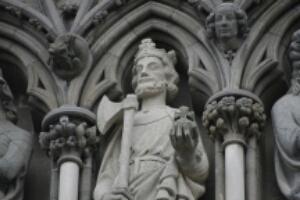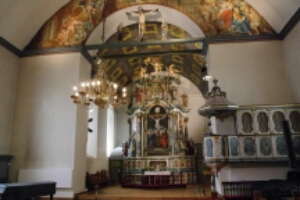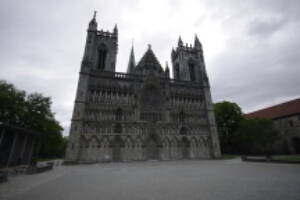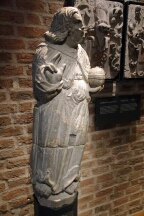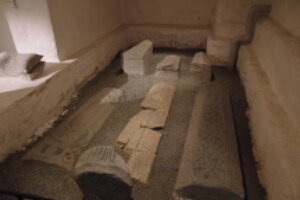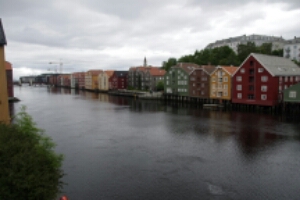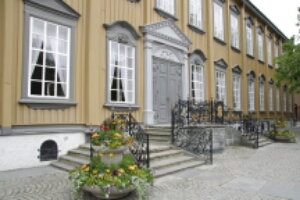Well, after the firealarm in the middle of the night, it wasn’t a great sleep. However, this morning we had a good breakfast here in the hotel, and then walked towards the Nidaros Cathedral. It was a gray and overcast morning.
About half way to our destination we stopped into another old stone church, Var Frue church. They keep it’s doors open to help homeless people, but I don’t believe that they have any other activity here.
After this we continued on to the main cathedral. When we arrived it was closed for a worship service (since it was Sunday morning). We got our tickets, and found that the tours would start at 1:15, so we walked around the grounds, viewing the cemetary. We saw no gravestones that pre-dated about 1800.
On our way back around the cathedral we joined the service which was underway, probably a bit after 1/2 done. I am glad that we did so. The choir, actually two choirs, one a boys/mens chorus, and the other a mixed choir, were accompanied by the pipe organ. The acoustics in the cathedral are phenomonal, with at least a two second reverberation. At the close of the service the choirs sang the Hallelujah Chorous, and I think it was the most spectacular acoustic performance of it I have ever heard. We were seated right below the pipe organ, and directly across from the boys choir.
After the service we went to the Archbishop’s Palace museum for about half an hour. Here they display many sculptures and artifacts from the church that have been preserved from some of the many restorations. As we found out later in our tour, part of the grounds were destroyed by fire in 1983, and after this they spent a lot of time doing archaeology of the site, and built this new museum.
Following lunch we re-entered the cathedral for our tour. The tour guide explained the history of the church, starting with Saint Olav in the early 1000’s (2015 is the 1000th anniversary of his becoming king of Norway). Sometime before this he converted to Christianity after going to England as a Viking warrior, and after his death was made a saint. He was buried on this site, and his tomb was marked by a small wooden church, that over the years grew to become the most northerly medieval cathedral in Eurome by the 1300’s.
Archbishop Eystein began construction of the cathedral in Romanesque style, so the oldest part of the building has rounded roman arches. However after his return from exile in England he changed the construction to become Gothic, so about 3/4 of the building has Gothic arches. There have been many fires in the cathedral, and the cathedral has been rebuilt, at least in part, several times. The most recent restoration began in 1869 and was completed in about 2001. All of the stained glass in the building is modern, installed after 1900.
After the reformation the church was converted to a Lutheran cathedral, and at this time Saint Olav’s grave was lost so no one knows where he may be actually buried in the church. In the basement of the church there are some crypts of wealthy people, and also a large display of gravestones, many of them dating to the 1300’s. These would be the graves of very wealthy people, as the poorer folk would only have had wooden crosses, so their graves are long lost.
After our guided tour of the church we crossed over to the museum area again, and saw a display of the very beautiful crown jewels of Norway. After this we went back to the museum, and spent another hour or so enjoying the history there. We have learned a lot about the history of Norway in the last two days, and it has been very interesting.
On our way back to the hotel we took a detour to the old city bridge. It is lined by colorful waterfront buildings. We also walked by Stiftsgarden, the residence of the Norwegian king when in Trondheim. We were too late in the day for a tour, and had done enough touring for the day anyway.

